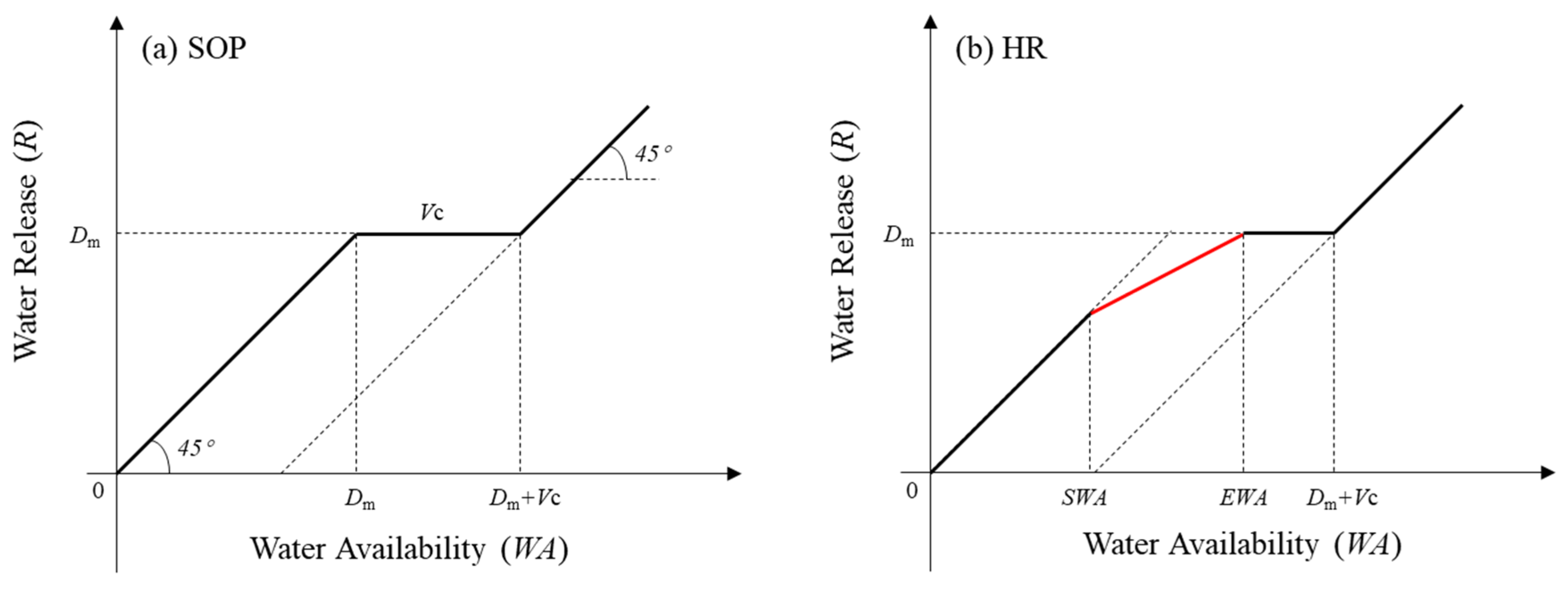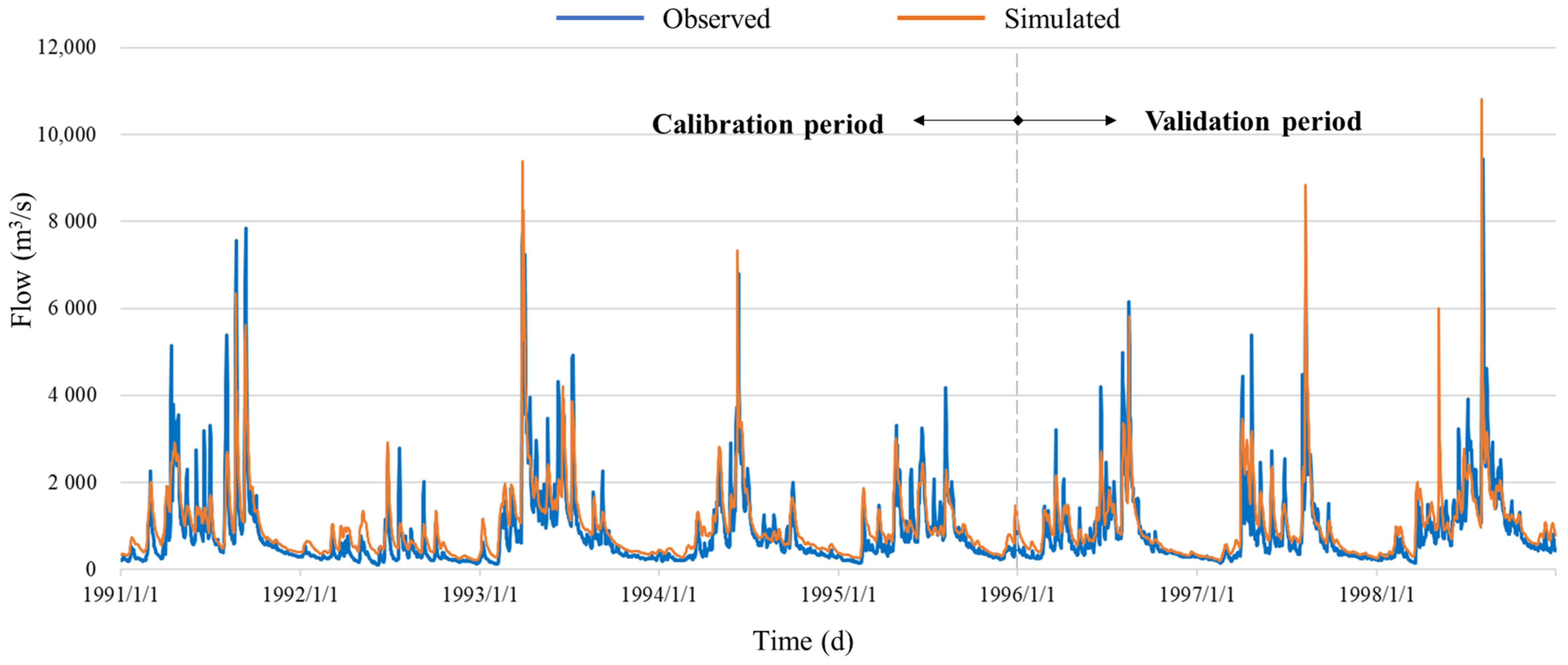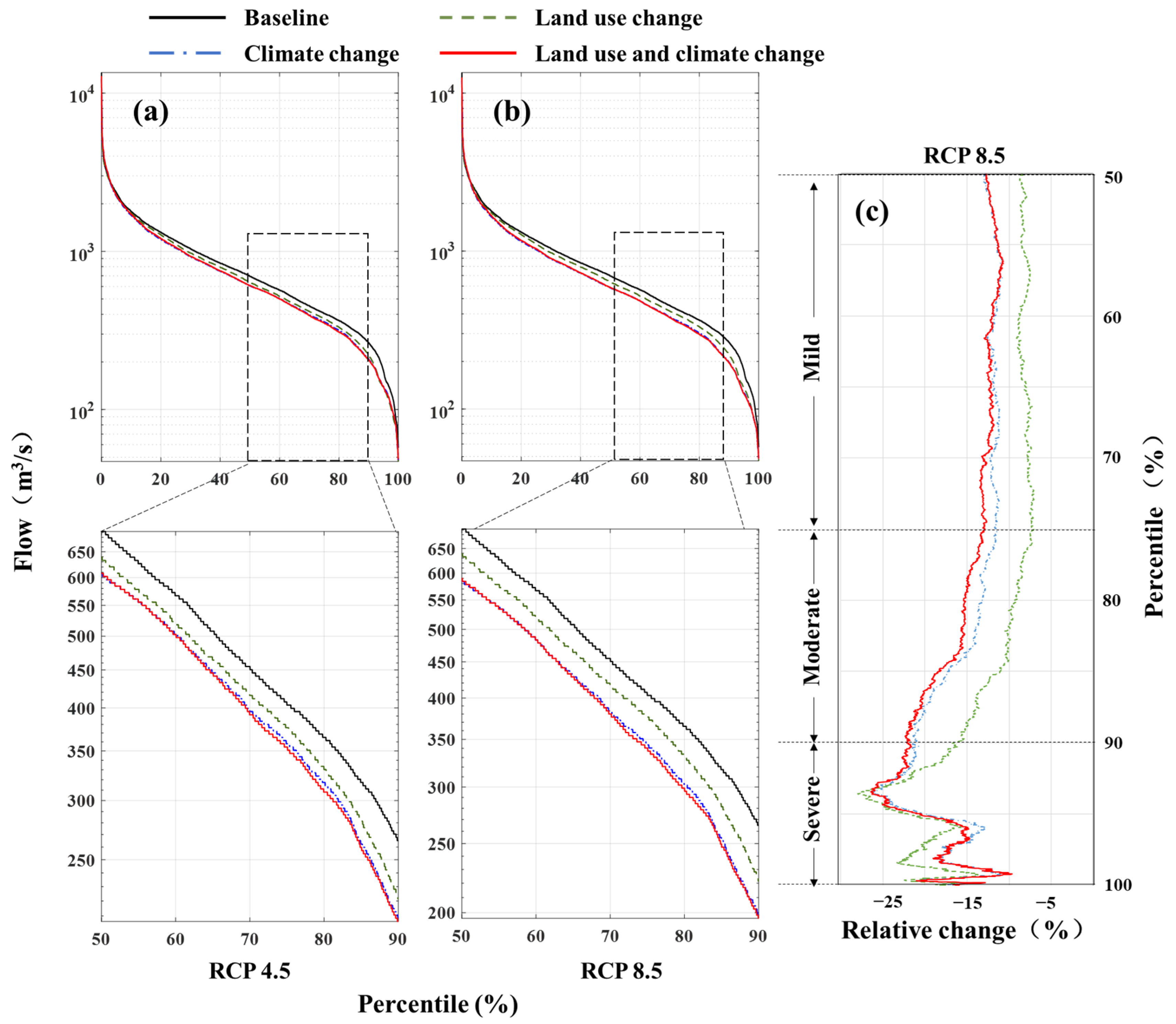Mitigating Drought Conditions under Climate and Land Use Changes by Applying Hedging Rules for the Multi-Reservoir System
Abstract
1. Introduction
2. Methodology
2.1. Hydrologic Model
2.2. Land Use Projections
2.3. Climate Change Projections
2.4. Multi-Reservoir Operation Model
2.4.1. Aggregation-Decomposition Method
2.4.2. Optimization Method
2.5. Evaluation Indicators
- (1.)
- Hydrologic model performance
- (2.)
- Regime changes
- (3.)
- Reservoir operation performance
3. Case Study
3.1. Study Area
3.2. Data
- (1.)
- Climate data
- (2.)
- Streamflow data
- (3.)
- Topographic, soil data, land use/cover
3.3. Reservoir Operation System
- (1.)
- Reservoirs
- (2.)
- Water diversion projects
- (3.)
- Water demand at the Chaoan section
4. Results and Discussion
4.1. Hydrologic Model Calibration and Validation
4.2. Land Use and Land Cover
4.3. Hydrological Flow Regime Changes
4.4. Assessment of Hedging Rules under Future Scenarios
4.5. Discussion
- (1.)
- On the changing environments
- (2.)
- On the joint operation of multi-reservoir system
- (3.)
- On the reservoir operating rules
5. Conclusions
- (1.)
- Hanjiang River Basin is expected to experience more severe drought conditions under the land use and climate changes. Lower flows are more sensitive to environmental changes and a decline of monthly flows can reach up to nearly 30% in the dry season.
- (2.)
- By applying HRs into the multi-reservoir operation in the Hanjiang River Basin, the water supply system can be more adaptive to the environmental changes in terms of reliability, resiliency, vulnerability, and sustainability, compared with SOPs and COs.
Author Contributions
Funding
Institutional Review Board Statement
Informed Consent Statement
Data Availability Statement
Acknowledgments
Conflicts of Interest
References
- Li, J.; Wang, Z.; Wu, X.; Zscheischler, J.; Guo, S.; Chen, X. A standardized index for assessing sub-monthly compound dry and hot conditions with application in China. Hydrol. Earth Syst. Sci. 2021, 25, 1587–1601. [Google Scholar] [CrossRef]
- Middelkoop, H.; Daamen, K.; Gellens, D.; Grabs, W.; Kwadijk, J.; Lang, H.; Parmet, B.W.A.H.; Schädler, B.; Schulla, J.; Wilke, K. Impact of Climate Change on Hydrological Regimes and Water Resources Management in the Rhine Basin. Clim. Chang. 2001, 49, 105–128. [Google Scholar] [CrossRef]
- Xu, Y.-P.; Zhang, X.; Ran, Q.; Tian, Y. Impact of climate change on hydrology of upper reaches of Qiantang River Basin, East China. J. Hydrol. 2013, 483, 51–60. [Google Scholar] [CrossRef]
- Cuo, L.; Lettenmaier, D.P.; Mattheussen, B.V.; Storck, P.; Wiley, M. Hydrologic prediction for urban watersheds with the Distributed Hydrology-Soil-Vegetation Model. Hydrol. Process. 2008, 22, 4205–4213. [Google Scholar] [CrossRef]
- Nie, W.; Yuan, Y.; Kepner, W.; Nash, M.S.; Jackson, M.; Erickson, C. Assessing impacts of Landuse and Landcover changes on hydrology for the upper San Pedro watershed. J. Hydrol. 2011, 407, 105–114. [Google Scholar] [CrossRef]
- Liu, Y.; Zhang, X.; Xia, D.; You, J.; Rong, Y.; Bakir, M. Impacts of land-use and climate changes on hydrologic processes in the Qingyi river watershed, China. J. Hydrol. Eng. 2013, 18, 1495–1512. [Google Scholar] [CrossRef]
- Wang, G.; Yang, H.; Wang, L.; Xu, Z.; Xue, B. Using the SWAT model to assess impacts of land use changes on runoff generation in headwaters. Hydrol. Process. 2012, 28, 1032–1042. [Google Scholar] [CrossRef]
- Li, J.; Wang, Z.; Wu, X.; Xu, C.-Y.; Guo, S.; Chen, X. Toward Monitoring Short-Term Droughts Using a Novel Daily Scale, Standardized Antecedent Precipitation Evapotranspiration Index. J. Hydrometeorol. 2020, 21, 891–908. [Google Scholar] [CrossRef]
- Yang, P.; Ng, T.L. Fuzzy Inference System for Robust Rule-Based Reservoir Operation under Nonstationary Inflows. J. Water Resour. Plan. Manag. 2017, 143, 04016084. [Google Scholar] [CrossRef]
- Biemans, H.; Haddeland, I.; Kabat, P.; Ludwig, F.; Hutjes, R.W.A.; Heinke, J.; Von Bloh, W.; Gerten, D. Impact of reservoirs on river discharge and irrigation water supply during the 20th century. Water Resour. Res. 2011, 47, W03509. [Google Scholar] [CrossRef]
- Chen, J.; Shi, H.; Sivakumar, B.; Peart, M.R. Population, water, food, energy and dams. Renew. Sustain. Energy Rev. 2016, 56, 18–28. [Google Scholar] [CrossRef]
- Mehran, A.; Mazdiyasni, O.; AghaKouchak, A. A hybrid framework for assessing socioeconomic drought: Linking climate variability, local resilience, and demand. J. Geophys. Res. Atmos. 2015, 120, 7520–7533. [Google Scholar] [CrossRef]
- Xu, W.; Zhao, J.; Zhao, T.; Wang, Z. Adaptive Reservoir Operation Model Incorporating Nonstationary Inflow Prediction. J. Water Resour. Plan. Manag. 2015, 141, 04014099. [Google Scholar] [CrossRef]
- Zhang, J.; Cai, X.; Lei, X.; Liu, P.; Wang, H. Real-time reservoir flood control operation enhanced by data assimilation. J. Hydrol. 2021, 598, 126426. [Google Scholar] [CrossRef]
- Georgakakos, A.P.; Yao, H.; Kistenmacher, M.; Georgakakos, K.P.; Graham, N.E.; Cheng, F.Y.; Spencer, C.; Shamir, E. Value of adaptive water resources management in Northern California under climatic variability and change: Reservoir management. J. Hydrol. 2012, 412–413, 34–46. [Google Scholar] [CrossRef]
- Bhaduri, A.; Bogardi, J.; Siddiqi, A.; Voigt, H.; Vörösmarty, C.; Pahl-Wostl, C.; Bunn, S.E.; Shrivastava, P.; Lawford, R.; Foster, S.; et al. Achieving Sustainable Development Goals from a Water Perspective. Front. Environ. Sci. 2016, 4, 64. [Google Scholar] [CrossRef]
- Shiau, J.T.; Lee, H.C. Derivation of optimal hedging rules for a water-supply reservoir through compromise programming. Water Resour. Manag. 2005, 19, 111–132. [Google Scholar] [CrossRef]
- Shih, J.; Revelle, C. Water-Supply Operations during Drought: Continuous Hedging Rule. J. Water Resour. Plan. Manag. 1994, 120, 613–629. [Google Scholar] [CrossRef]
- You, J.-Y.; Cai, X. Hedging rule for reservoir operations: 1. A theoretical analysis. Water Resour. Res. 2008, 44, W01415. [Google Scholar] [CrossRef]
- Steinschneider, S.; Brown, C. Dynamic reservoir management with real-option risk hedging as a robust adaptation to nonstationary climate. Water Resour. Res. 2012, 48, W05524. [Google Scholar] [CrossRef]
- Karamouz, M.; Imen, S.; Nazif, S. Development of a Demand Driven Hydro-climatic Model for Drought Planning. Water Resour. Manag. 2011, 26, 329–357. [Google Scholar] [CrossRef]
- Adeloye, A.J.; Soundharajan, B.-S. Effect of reservoir zones and hedging factor dynamism on reservoir adaptive capacity for climate change impacts. Proc. Int. Assoc. Hydrol. Sci. 2018, 379, 21–29. [Google Scholar] [CrossRef][Green Version]
- Alimohammadi, H.; Massah Bavani, A.R.; Roozbahani, A. Mitigating the impacts of climate change on the performance of multi-purpose reservoirs by changing the operation policy from SOP to MLDR. Water Resour. Manage. 2020, 34, 1495–1516. [Google Scholar] [CrossRef]
- Ahmadianfar, I.; Zamani, R. Assessment of the hedging policy on reservoir operation for future drought conditions under climate change. Clim. Chang. 2020, 159, 253–268. [Google Scholar] [CrossRef]
- Lei, X.; Zhang, J.; Wang, H.; Wang, M.; Khu, S.-T.; Li, Z.; Tan, Q. Deriving mixed reservoir operating rules for flood control based on weighted non-dominated sorting genetic algorithm II. J. Hydrol. 2018, 564, 967–983. [Google Scholar] [CrossRef]
- Oliveira, R.; Loucks, D.P. Operating rules for multireservoir systems. Water Resour. Res. 1997, 33, 839–852. [Google Scholar] [CrossRef]
- Zhang, J.; Wang, X.; Liu, P.; Lei, X.; Li, Z.; Gong, W.; Duan, Q.; Wang, H. Assessing the weighted multi-objective adaptive surrogate model optimization to derive large-scale reservoir operating rules with sensitivity analysis. J. Hydrol. 2016, 544, 613–627. [Google Scholar] [CrossRef]
- Saad, M.; Turgeon, A.; Bigras, P.; Duquette, R. Learning disaggregation technique for the operation of long-term hydroelectric power systems. Water Resour. Res. 1994, 30, 3195–3202. [Google Scholar] [CrossRef]
- Zhang, J.; Li, Z.; Wang, X.; Lei, X.; Liu, P.; Feng, M.; Khu, S.-T.; Wang, H. A novel method for deriving reservoir operating rules based on flood classification-aggregation-decomposition. J. Hydrol. 2018, 568, 722–734. [Google Scholar] [CrossRef]
- Arnold, J.G.; Srinivasan, R.; Muttiah, R.S.; Williams, J.R. Large area hydrologic modeling and assessment part i: Model development. Jawra J. Am. Water Resour. Assoc. 1998, 34, 73–89. [Google Scholar] [CrossRef]
- Li, Z.; Liu, P.; Feng, M.; Cui, X.; He, P.; Wang, C.; Zhang, J. Evaluating the Effect of Transpiration in Hydrologic Model Simulation through Parameter Calibration. J. Hydrol. Eng. 2020, 25, 04020007. [Google Scholar] [CrossRef]
- Li, Z.; Liu, P.; Deng, C.; Guo, S.; He, P.; Wang, C. Evaluation of Estimation of Distribution Algorithm to Calibrate Computationally Intensive Hydrologic Model. J. Hydrol. Eng. 2016, 21, 04016012. [Google Scholar] [CrossRef]
- Abbaspour, K.C.; Yang, J.; Maximov, I.; Siber, R.; Bogner, K.; Mieleitner, J.; Zobrist, J.; Srinivasan, R. Modelling hydrology and water quality in the pre-alpine/alpine Thur watershed using SWAT. J. Hydrol. 2007, 333, 413–430. [Google Scholar] [CrossRef]
- Sang, L.; Zhang, C.; Yang, J.; Zhu, D.; Yun, W. Simulation of land use spatial pattern of towns and villages based on CA–Markov model. Math. Comput. Model. 2010, 54, 938–943. [Google Scholar] [CrossRef]
- Dang, A.N.; Kawasaki, A. Integrating biophysical and socio-economic factors for land-use and land-cover change projection in agricultural economic regions. Ecol. Model. 2017, 344, 29–37. [Google Scholar] [CrossRef]
- Navarro-Racines, C.E.; Tarapues, J.; Thornton, P.; Jarvis, A.; Ramirez-Villegas, J. High-resolution and bias-corrected CMIP5 projections for climate change impact assessments. Sci. Data 2020, 7, 1–14. [Google Scholar] [CrossRef] [PubMed]
- Räty, O.; Räisänen, J.; Ylhäisi, J.S. Evaluation of delta change and bias correction methods for future daily precipitation: Intermodel cross-validation using ENSEMBLES simulations. Clim. Dyn. 2014, 42, 2287–2303. [Google Scholar] [CrossRef]
- Asadzadeh, M.; Tolson, B. Pareto archived dynamically dimensioned search with hypervolume-based selection for multi-objective optimization. Eng. Optim. 2013, 45, 1489–1509. [Google Scholar] [CrossRef]
- Asadzadeh, M.; Tolson, B.A.; Burn, D.H. A new selection metric for multiobjective hydrologic model calibration. Water Resour. Res. 2014, 50, 7082–7099. [Google Scholar] [CrossRef]
- He, S.; Guo, S.; Yang, G.; Chen, K.; Liu, D.; Zhou, Y. Optimizing Operation Rules of Cascade Reservoirs for Adapting Climate Change. Water Resour. Manag. 2019, 34, 101–120. [Google Scholar] [CrossRef]
- Yang, G.; Guo, S.; Liu, P.; Li, L.; Xu, C.-Y. Multiobjective reservoir operating rules based on cascade reservoir input variable selection method. Water Resour. Res. 2017, 53, 3446–3463. [Google Scholar] [CrossRef]
- Thompson, J.R.; Laizé, C.L.R.; Green, A.J.; Acreman, M.C.; Kingston, D.G. Climate change uncertainty in environmental flows for the Mekong River. Hydrol. Sci. J. 2014, 59, 935–954. [Google Scholar] [CrossRef]
- Asefa, T.; Clayton, J.; Adams, A.; Anderson, D. Performance evaluation of a water resources system under varying climatic conditions: Reliability, Resilience, Vulnerability and beyond. J. Hydrol. 2013, 508, 53–65. [Google Scholar] [CrossRef]
- Kjeldsen, T.R.; Rosbjerg, D. Choice of reliability, resilience and vulnerability estimators for risk assessments of water resources system. Hydrol. Sci. J. 2004, 49, 767. [Google Scholar] [CrossRef]
- Qin, J.; Fu, X.; Peng, S.; Xu, Y.; Huang, J.; Huang, S. Asymmetric Bargaining Model for Water Resource Allocation over Transboundary Rivers. Int. J. Environ. Res. Public Health 2019, 16, 1733. [Google Scholar] [CrossRef]
- Bayazit, M.; Ünal, N.E. Effects of hedging on reservoir performance. Water Resour. Res. 1990, 26, 713–719. [Google Scholar] [CrossRef]
- Ahmadi, M.; Haddad, O.B.; Loáiciga, H.A. Adaptive Reservoir Operation Rules under Climatic Change. Water Resour. Manag. 2014, 29, 1247–1266. [Google Scholar] [CrossRef]
- Zhou, Y.; Guo, S. Incorporating ecological requirement into multipurpose reservoir operating rule curves for adaptation to climate change. J. Hydrol. 2013, 498, 153–164. [Google Scholar] [CrossRef]











| MHT | CT | HS | YT | GB | |
|---|---|---|---|---|---|
| Catchment area (km2) | 7907 | 1990 | 251 | 578 | 26,590 |
| Normal water level (m) | 173 | 148 | 138 | 153 | 38 |
| Dead water level (m) | 146 | 136.5 | 132.5 | 133 | 28 |
| Active storage (106 m3) | 1122 | 54.5 | 41.3 | 107 | 93.9 |
| Total storage (106 m3) | 2035 | 172 | 116 | 166 | 365.6 |
| Period | NSE | RE (%) | R2 | ||
|---|---|---|---|---|---|
| Daily | Monthly | Daily | Monthly | ||
| Calibration | 0.75 | 0.84 | −7.53 | 0.74 | 0.84 |
| Validation | 0.71 | 0.87 | 9.70 | 0.73 | 0.92 |
| Characteristics | Current (m3/s) | lu2050 (%) | rcp45 (%) | rcp85 (%) | rcp45_lu2050 (%) | rcp85_lu2050 (%) | |
|---|---|---|---|---|---|---|---|
| Magnitude | Q90 | 225.2 | −1.8 | −7.5 | −11.9 | −8.4 | −12.5 |
| Qmin7 | 49.0 | −0.6 | +1.3 | +0.7 | +2.1 | +1.4 | |
| 852.0 | +0.6 | −2.3 | −5.2 | −1.5 | −4.4 | ||
| Variability | Qvar | 414.0 | +0.4 | −3.9 | −6.3 | −3.2 | −5.4 |
Publisher’s Note: MDPI stays neutral with regard to jurisdictional claims in published maps and institutional affiliations. |
© 2021 by the authors. Licensee MDPI, Basel, Switzerland. This article is an open access article distributed under the terms and conditions of the Creative Commons Attribution (CC BY) license (https://creativecommons.org/licenses/by/4.0/).
Share and Cite
Li, Z.; Huang, B.; Yang, Z.; Qiu, J.; Zhao, B.; Cai, Y. Mitigating Drought Conditions under Climate and Land Use Changes by Applying Hedging Rules for the Multi-Reservoir System. Water 2021, 13, 3095. https://doi.org/10.3390/w13213095
Li Z, Huang B, Yang Z, Qiu J, Zhao B, Cai Y. Mitigating Drought Conditions under Climate and Land Use Changes by Applying Hedging Rules for the Multi-Reservoir System. Water. 2021; 13(21):3095. https://doi.org/10.3390/w13213095
Chicago/Turabian StyleLi, Zejun, Bensheng Huang, Zhifeng Yang, Jing Qiu, Bikui Zhao, and Yanpeng Cai. 2021. "Mitigating Drought Conditions under Climate and Land Use Changes by Applying Hedging Rules for the Multi-Reservoir System" Water 13, no. 21: 3095. https://doi.org/10.3390/w13213095
APA StyleLi, Z., Huang, B., Yang, Z., Qiu, J., Zhao, B., & Cai, Y. (2021). Mitigating Drought Conditions under Climate and Land Use Changes by Applying Hedging Rules for the Multi-Reservoir System. Water, 13(21), 3095. https://doi.org/10.3390/w13213095







